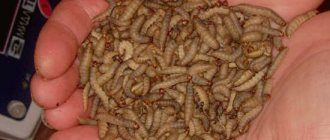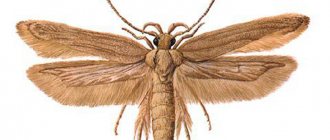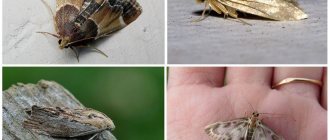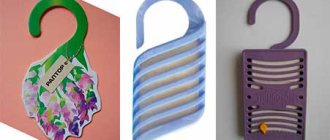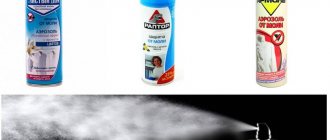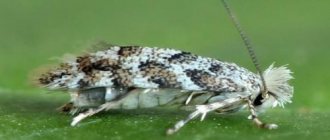General information
Moths in the house are not dangerous in themselves. But they are an indicator of a problem. Depending on the species, there are clothes moths and food moths. These names suggest where the moth nest can be found. Diet preferences also depend on this. Clothes prefers to feed on natural furs and fabrics, and can migrate to furniture upholstery or carpets in a hungry year. Accordingly, the food industry prefers groceries, tea or dried fruits. Moreover, one type of moth does not change its taste preferences and does not switch to another type of food.
How dangerous are moths and their larvae?
An adult moth is not dangerous because it does not bite and does not carry pathogens or infections. The main harm from it is the laying of a large number of eggs, from which real pests - larvae - will appear.
The greatest danger to humans is larvae of food moths. It spoils food and contaminates it with waste products. Cereals or dried fruits in which moths have infested should not be used for food. Otherwise, consequences may arise in the form of:
- allergies;
- digestive disorders;
- poisoning
Clothes moths damage clothing, furniture upholstery, and carpets. For people prone to allergies, wearing moth-infested clothing can cause skin irritation. In addition, the presence of moths causes psychological discomfort.
Types of moths in the apartment
Most often, one of the following five varieties of moths can be found in an apartment. Outwardly they are very similar, however, each species has its own food preferences . That is, if you find grain moths, you can rest assured about the integrity of your clothes, and vice versa.
- House moth (clothes moth) has a faded, yellowish color with barely noticeable purple tints. Lives in dark closets with a lot of clothes made from natural fabrics - wool, linen, silk, velvet and feathers.
- Furniture - a gray , inconspicuous moth whose larvae live in foam rubber , upholstery of chairs, sofas and carpet pile . Parasite infestations are transferred from one piece of furniture to another . Most often this happens in furniture warehouses, or after purchasing a used interior item.
- Kitchen - most often starts in closed, unventilated containers with flour, cereals and grains. They get into the apartment from the store if the integrity of the product packaging has been even slightly damaged.
- Cereal – consumes both bulk and non-bulk products. The presence of small gray moths in the kitchen indicates the need for general cleaning and sorting through all the grains for larvae.
- Grain - found on land where grain crops are grown and in barns where the harvest is stored . Sometimes it can move into living quarters. Adults of this species look like small gray-yellow moths . The back side of their wings is silvery.
not to eat food products in which moths have been found even though they are disinfected after heat treatment. The fact is that of insect activity or even small may remain . For example, grain moth caterpillars gnaw holes in grains and live inside until they enter the moth stage.
Life cycle of a moth
The lifespan of a moth is not very long. But during this period it reproduces quite actively, so it can cause a lot of harm. There are several stages of development.
Development takes place in several stages:
- adult insect. The female lays eggs, their number can reach 200 pieces, and dies after 4-5 days;
- eggs. They are very small and can be collected in one place or spread over some surfaces;
- larvae. Appear small and whitish after 14 days. The lifespan of this pest reaches 50 days, and at this time it causes maximum damage;
- The pupae appear after the insects have eaten enough to make a cocoon. After a month, which is how long this stage lasts, an adult appears.
This is what the life cycle of a moth looks like.
Each individual goes through this life cycle.
How long does he live?
The life span of the pest from the first stage to the end of its life cycle can reach 2 years and 5 months. However, it is directly affected by living conditions, because moths do not like low temperatures and heat. Also, how long moths live in indoor conditions directly depends on the active struggle of the owners.
How does it reproduce
The process of reproduction takes place sexually, with the participation of individuals of both sexes. Most often this happens immediately after the butterfly appears. After a few days, egg laying begins in the same place where the insects will grow and feed. In comfortable conditions, even 5 generations develop within a year.
How it spreads
There are several possible ways for moths to appear in a house or apartment. If it is a food pest, it may have been brought from a store or market. If the seal of the food package was broken or errors were made during storage, then it is likely that contamination will occur.
The same applies to the clothing subspecies. It can be carried on things, dilapidated pieces of furniture, carpets that were not stored correctly. They can use thick, long dog hair to move around.
Clothes moth on the carpet.
Infection of human housing occurs from the street or ventilation pipes. A butterfly or several can very easily get in from an open window, and then it’s a matter of time before there becomes a whole flock of them.
Types of moths and their ways of entering the home (video)
Each moth lays up to 200 eggs. They are oval in shape, up to 0.6 mm in size. Moth caterpillars reach a length of a centimeter. They are yellowish in color, but are capable of changing their skin several times during their life. At this stage of development, the larvae can live from 70 to 200 days. The cooler the house, the longer the larval stage. In unfavorable conditions and in the absence of food, the larva can exist for up to 2 years. The clothes moth produces only one generation per year, which is determined by the feeding conditions of its larvae and the duration of their development.
How to prevent moths from appearing?
Preventive measures that will prevent the appearance of uninvited tenants are simple. When bringing old things into the house, they must be properly disinfected - washed, cleaned. Particular attention should be paid to new furniture - armchairs, chairs, sofas, where butterflies and their larvae most often live. It is recommended to thoroughly ventilate large products or keep them in direct sunlight - insects die in such conditions.
Other measures to prevent the infestation of things by moths:
- Use special aerosols before storing clothes.
- Ventilate wardrobes and closets more often, shake out linen and blankets.
- Moths cannot tolerate the aroma of lavender, orange, lemon, or wormwood, so you can put appropriate sachets in cabinets or drop a little essential oil on a cotton pad.
- It is good to inspect all things brought from the store, especially those made of wool or fur.
- Small woolen items can be periodically dried on a radiator, large ones can be taken out into the cold, because moths cannot tolerate both types of temperature changes.
In the kitchen, all food should be kept in containers with tightly fitted lids. Spoiled flour and cereals with worms should be thrown away immediately.
Kitchen cabinets must be washed and wiped regularly. You can put lavender in them to repel insects. If pests do get into the house, you will have to part with spoiled food and things without pity, and then use means to combat them (insecticides).
Tips to help get rid of moths:
Ways to enter the apartment
Causes of moths
There are several versions of where moths come from in an apartment or house:
- A butterfly flies into a room in the evening through open windows. The moth is nocturnal, at this time mating occurs, and the female begins to look for a suitable place to lay eggs. Moths are attracted to bright light, so at the slightest opportunity the butterfly enters the apartment.
- The reasons for the appearance of moth larvae and eggs are contaminated foods, things that a person himself brings into his home from a store, warehouse, barn, or garden. Moth eggs may appear on the surface of apples, pears, with larvae inside. Often, infection of an apartment occurs through stored dried fruits. From there, the larvae move to all cereals and food supplies.
Where the moth comes from is extremely clear, but a person may not always notice the moment of infection. It is impossible to notice small eggs of the pest in cereals, products, or things. Their sizes are extremely small, the coloring resembles a speck that accidentally clings.
Important!
How clothes moths appear in an apartment, in most cases through open windows. Once in the house, the butterfly immediately looks for wool clothing by smell. However, it is not the fur itself that attracts insects, but the presence of the smell of sweat on it. If you leave unwashed things in the closet, the moth initially makes its way to them, then finds wool, fur coats, hats, and fur products.
Ways to get into the house
Where do clothes moths come from in the house? It enters the house in approximately the same ways as food:
- through open windows and doors;
- together with old things affected by moths;
- through the ventilation holes.
To protect your home from clothes moths, you need to carefully check all things brought into the house. Special attention should be paid to various antique items that have old textiles, leather or fur. Moth larvae can live here, which, under favorable conditions at home, will reach the adult stage and begin to reproduce.
Signs of infection
Signs of the presence of moths
You can learn about the existence of moths in an apartment by fluttering butterflies and caterpillars. Moths are active in the dark and often appear in the evening. During the day, moths hide in dark places, away from bright sunlight. If the apartment is heavily infested, moths can be found during the day, and not only in the room where the larvae are parasitizing.
The second obvious sign is caterpillars. Periodically, they crawl out of infected cereals and travel around the apartment. You can meet them in the kitchen, bedroom, living room. The caterpillars develop from 1 to 2 months, at the last stage they reach a size of 1.5 cm and pupate. After a few days, sexually mature adults emerge and immediately begin mating and laying eggs. In 14 days, one female is capable of laying about 100 eggs.
Contaminated products look disgusting, disgusting, terrifying. In one place there are caterpillars of different sizes, excrement, moths, pupae, and cobwebs. Such a sight is found even in hermetically sealed cereals - in bags.
On a note!
Food moths never attack fur products, and clothing moths do not grow in cereals. But to prevent re-infection, general cleaning should be carried out throughout the apartment.
Life cycle
How long does a pest live? Development comes with complete transformation. The insect lays eggs (60-230 pieces). After 13 days at a temperature of 20 degrees, they produce caterpillars. The latter are engaged in the construction of cocoons from the nutritious material on which they live. How long does a moth spend in the butterfly state? The stage lasts approximately 7 months. The insect spends up to 44 days as a pupa.
Fledged individuals can live up to 4 weeks. Over the course of a year, pests produce 2 generations if they are in a room at room temperature.
In the process of evolution, the house moth has lost its oral apparatus as unnecessary
How to find a mole?
When the insect reaches normal size for an adult, its activity increases sharply. The pest begins to fly relatively long distances. Narrow openings and cracks do not become an obstacle for moths. Pregnant females fly poorly, so males most often do this.
To find moths, you should look in the folds of clothing where they lay their eggs. The moth prefers to lay eggs in a moist environment. You can find the insect in containers or bags filled with cereals. The risk of this increases if products are stored in basements. Moths often hide in rolled carpets, fur items and folded blankets.
Where do moths come from in an apartment?
These insects appear in homes in different ways. The method of their appearance depends on whether they infect food or clothing.
food moth
Insect larvae can feed on a variety of foods, including:
- flour;
- grains (oats, barley, wheat);
- oat and corn flakes;
- bakery products;
- pasta;
- sugar;
- seeds;
- nuts;
- cereals (buckwheat, corn, semolina, rice);
- dried fruits, etc.
It is believed that different types of moths are able to absorb only one particular food. In practice, any insect eats any food. Food black moths are not capable of ruining clothes. This is due to the fact that its digestive juices contain enzymes that cannot digest tissue fibers.
Clothes parasites
Moth larvae and eggs can get into your closet even with new clothes purchased from large stores. The sources of damage are woolen products and upholstered furniture, the upholstery of which is made of natural materials. The risk of moths entering the closet increases if worn items are purchased. The insect destroys the following clothing:
- knitwear;
- fur-lined shoes;
- cashmere, leather and cotton clothes;
- furniture upholstery;
- woolen products;
- sheepskin coats and fur coats based on natural fur;
- carpets;
- felt boots;
- bedding based on natural materials.
Moths can destroy any natural fabric. If the synthetic material contains a small amount of wool or cotton, the insect can damage it too. The pest prefers to eat clothes that have particles of epidermis or sweat on them. In order to save the fabric, people often wrap it in cellophane film, but the insect has no problem chewing through it.
Coat moth
Its larvae feed on fur. They look like worms, their color is white, but the moth itself is gray.
Grain moth
It feeds on seeds, dried fruits, and harms wheat, barley and other crops. This type of moth can lay a huge number of eggs, leaving several of them on each grain. Moth larvae appear in spring and summer. The color of the grain moth is predominantly silver.
Furniture moth
The larvae of such moths can live in furniture made of natural facing fabric. Furniture moths usually feed on hairs from the upholstery. They can also form nests in the interior and lower parts of furniture, and in cabinet parts.
Wax moth
Causes great damage to bee hives; the caterpillars of such moths harm bee larvae, eat honey and destroy the insulation used to protect bee hives from low air temperatures.
Potato moth
In an apartment, potato moth can appear directly in the place where potatoes are stored if the product has been infected with its larvae. Infected potatoes must be thrown away before the moth larvae spread to the entire storage area.
How to get rid of moths in an apartment
How to get rid of moth larvae? In just a month of active existence, the caterpillar is capable of destroying clothes in the dressing room. And if eggs nest on neighboring products, then the epic may drag on. The fight against the parasite must be carried out in four stages.
- Get rid of damaged items. From the closet where the moth nest was, throw out all the clothes.
- Clean all corners. Thoroughly vacuum every nook and cranny of the closet.
- Disinfect the shelves. Wash the shelves and interior walls with soap and water. Then wipe the cabinet with a vinegar solution and spray an aerosol inside.
- Process whole things. Throw the clothes into the washing machine and wash in hot water. Place items that cannot be heat treated in a plastic bag and put them in the freezer for a day. Then wash on an acceptable cycle.
Chemicals and traps
Professional remedies are considered the most effective to get rid of moths in the house. The most popular drugs include the following.
- Fumigator. It is an electrical device into which an insecticide is placed in a plate. The device is plugged in, and when heated, the plate begins to evaporate. The smell can destroy moths at any stage of development in just a few days. The most popular fumigators are “Raid” and “Raptor”.
- Sections. Thin plates with a chemical inside. The product gradually evaporates, scaring away adults. They are not capable of destroying the parasite larvae. The most effective sections are “Raptor” and “Moskitol”.
- Aerosols. Spray inside the closet, on clothing, carpets and furniture lining. It copes well with moths and larvae, but the toxic composition is harmful to humans and pets. It is best to leave the room during treatment and thoroughly ventilate it after the procedure. The most effective aerosols: “Armol”, “Raptor”, “Moskitol”, “Extramit”. The effect of the spray lasts for a year.
- Traps. Filled with pheromones, they attract the attention of adults. Males fly into a sticky trap and remain in it forever, since it is made on the basis of a sticky substance. The main advantage of this product is its natural composition and lack of odor.
- Case. Designed to protect expensive outerwear. The cover is impregnated with chemicals that repel larvae and adults.
- Liquid preparations. Used to process carpets, curtains and furniture upholstery. Treated items are put into a case for prevention.
The larvae adhere weakly to fabric fibers. To get rid of them, shake things on the balcony or outside.
Smelling household products
If you avoid using chemicals, then focus on folk remedies to get rid of moths in your clothes closet. It is not necessary to poison yourself with toxic fumes; moths are afraid of the pungent odors of herbs and flowers.
- Lavender. Pack dry inflorescences in small bags and place them on the shelves of your wardrobe. The aroma of lavender will scare adults away from textiles.
- Garlic. Place a clove of garlic in your fur coat and coat pockets. A pungent smell will force butterflies to change their habitat.
- Laundry soap. Cut the soap into pieces, put it in your pockets, on the shelves of your dresser. Butterflies will not fly to the closet.
- Geranium. Clothes moths cannot tolerate the smell of the flower. It is enough to place it on the windowsill and ventilate the dressing room from time to time. Over time, the butterflies will leave the room.
- Dill. The female cannot stand the smell of dill. Dry the plant, pack it in rag bags, and place it in secluded corners of the apartment.
- Tansy. Dried tansy inflorescences will fill the dressing room with aroma, this will save the contents of the cabinets from pest attacks.
- Oils. Soak cotton sponges in aromatic oils of walnut, geranium or lavender and place them on the shelves in your closet. This is an excellent prevention against the reproduction of adult individuals.
- Citrus. Place fresh orange or lemon peels in the chest of drawers where you store your favorite sweaters.
Clothes moths at any stage of development cannot tolerate sudden temperature changes. Don't forget to ventilate the room more often. To save your favorite things, take them out into the cold. Or place in a hot environment, the temperature should be above 30°C.
What to do if moths appear in the apartment
To answer the question - how to destroy moths in an apartment at home forever, you need to know several useful recommendations that will help in solving the problem.
- When you see a moth, inspect the entire room. She rarely appears in the house alone. You also need to review all products if an insect is found in the kitchen. Don’t forget to go through your cabinets and textiles just in case.
- If a nest with larvae is found, it must be immediately eliminated using a vacuum cleaner, and then the area must be washed with a chlorine-containing detergent.
Moths in the apartment - general characteristics
A moth is medium-sized insect from the order Lepidoptera . It is nocturnal , so it can be found mainly in the evening.
The moths themselves are harmless to property - their main function is to leave behind as many offspring . The greatest damage is caused by larvae , which from their very birth begin to actively absorb everything that surrounds them.
Even at the larval stage, the moth consumes so much food that it has enough energy reserves for the rest of its life until the moment of reproduction. Natural death from starvation occurs a few hours after laying eggs. If you notice insects your home , it means that the larvae have already settled in a secluded corner and have begun to destroy your clothes, furniture or food. To understand what exactly was damaged, you need to understand what types of moths exist, where they live and what they eat.
How to deal with moths in the house?
Countering the pest in question involves the use of both chemicals and folk remedies.
Aerosols
These products are sold in special cans. Since they are pesticides, a number of factors must be taken into account when using them:
- degree of toxicity of the main substance;
- processing area;
- Are there any allergy sufferers or small children in the house?
The most popular drugs:
- Raptor. Expensive, but effective.
- Clean house. It is used for processing clothes. Showed good results.
- Armol. It is considered a non-toxic product, so it can be used even in the kitchen.
Rules of use:
- Read the instructions.
- Use protective equipment.
- Open the windows for air flow.
- Treat the entire room, not just contaminated areas.
- Furniture needs to be closed for the best effect of the product.
Then the room is ventilated, and at the end of the processing, all things are put into place.
Pheromone traps
Traps are considered one of the most effective ways to get rid of annoying flies. If you still don’t know how to remove moths from your apartment, then you should try this method.
The trap is a small piece of cardboard, which is treated with a special substance that resembles the pheromones of a female moth.
A male individual flies at him, sticks and dies. Since there is no one to create offspring, the life cycle of the moth ends here.
Sections
These are special containers containing an insect repellent substance that lasts 2-3 months.
The most popular brands:
- raptor;
- mosquitol;
Fumigators
They are used to kill mosquitoes. But according to some reports, the plates and liquid will help in the fight against moths. They can also be used to remove poplar moths. Although this insect does not cause much harm, its huge number in the house causes discomfort.
The fumigator is less toxic than an aerosol, so it is safer for humans.
Principle of operation:
- Install the plate or pour the liquid into the container provided for this purpose.
- Connect to an outlet.
- Do not turn off until the substance takes effect.
The most popular fumigators:
- raid;
- mosquitol;
The advantage of using them is that by destroying mosquitoes, moth prevention is carried out.
Tablets and plates
Tablets are a classic remedy for killing indoor moths. They often contain naphthalene. Its heavy chemical vapors come from top to bottom, so the tablets should be placed on the top shelves of cabinets. The product allows you to quickly repel pests. The advantages of such a substance include low cost and ease of use. The negative sides of the tablets are:
- repelling pests instead of their desired destruction, which may lead to relapse in the future;
- high concentration of naphthalene vapors, which can cause harm to humans;
- short effect.
The plates are cardboards impregnated with a chemical. They look like the contents of fumigators. They need to be placed in places where many insects live. The plates are capable of destroying pest larvae, preventing its reproduction. This is a safe product that is inexpensive. When using, the plates should be placed at the top of cabinets and furniture, since the smell from them spreads from top to bottom.
Gels
Gel suspensions are a high-quality remedy against moths on clothes. These are cheap chemicals that are easy to store in a cabinet. They are 2 pendants made of plastic, inside of which there is transfluthrin in the form of a gel. It is the active ingredient of the drug. It is necessary to remove the protective film, and the pesticide is ready for use for its intended purpose.
Moth repellent gel is toxic and precautions must be taken when using it. The drug may provoke the development of an allergic reaction.
Plants
In the fight against moths, it is recommended to use crops that emit a powerful aroma that is toxic to insects. Most often dried flowers of herbs such as:
- tansy;
- lavender;
- sagebrush;
- mint;
- sweet clover;
- yarrow;
- chestnut;
- sage, etc.
Essential oils
To combat moths, these substances can be used both in their pure state and in the form of alcohol-based essences. The most commonly used oils are:
- clove;
- camphor;
- orange;
- lavender;
- geranium;
- cedar;
- lemon, etc.
Ways to get rid of moths
Humanity has come up with many ways to fight moths. Such methods can be divided into two categories: chemical and folk. The first method involves the use of special toxic drugs, while the second involves the use of natural remedies, as well as various unconventional techniques.
Chemicals
Today, there are several types of drugs for exterminating household pests on the market. All products are relatively safe for humans, but it should be remembered that they contain chemicals, so they must be used with caution. The most popular and effective are:
- Fumigators are special devices that run on electricity and produce toxic gases that kill insects. Manufacturers claim that such fumes do not harm humans, but this has not been proven.
One of the most effective devices for fighting insects. It is advisable to ventilate the room after use. - Aerosols and sprays are the most effective and fastest means of combating both flying moths and their larvae. The drugs are sprayed into the air and also treated with contaminated objects and clothing. The active substance acts instantly. Such products should be used very carefully if there are animals or small children in the apartment.
- Tablets and plates are relatively inexpensive products that are placed on the inside side walls of cabinets and in the items themselves. These products for the most part do not kill, but repel insects by smell, so if there are already moth larvae in the house, they will be ineffective.
- Traps are small boxes that, using a special dispenser that releases female pheromones, attract male moths, and an adhesive substance inside the structure prevents them from getting back out. Thus, the number of insects is significantly reduced, as a result of which the intensity of their reproduction also decreases. Traps are placed in places where the pest may live.
Traditional methods
The advantage of folk methods of fighting moths is that they are not only effective, but also completely harmless to humans. Another advantage of such funds is their low cost and wide availability. The most famous and effective methods :
- The pest cannot tolerate the cedar aroma. By placing pieces of wood and cedar branches in a closet or pantry, you can save not only your favorite fur coat, but also other things from moths. The essential oil of the same name has the same effect.
The vapors of this oil at room temperature are not harmful to humans or other creatures. Acts as a repellent - Ordinary laundry soap also helps to get rid of moths: just spray it on the walls and shelves of a cabinet or cabinet, and then leave a few remnants there.
- Naphthalene is a remedy that has been known for hundreds of years and still works to this day. However, scientists have recently discovered that the drug contains strong carcinogens, so using naphthalene against food moths is not recommended.
- Citrus peels are a traditional folk effect. Moth butterflies cannot stand the aroma of orange, tangerine, lemon and grapefruit, so fresh peels of these fruits, laid out on shelves with things or products, will prevent the pest from laying eggs in these places. Unfortunately, this method can only be used for prevention, since it will not help destroy the larvae.
- Geranium, lavender, mint, thyme, cloves and rosemary - all these herbs have a similar effect to the previous option.
Lavender, like all herbs, should be dried to achieve better results. - Vinegar and garlic are excellent helpers for fighting moths. A small amount of vinegar is added to warm water, then the walls and shelves of the furniture are thoroughly wiped with this solution, after which garlic cloves are placed between the items. This method can be considered drastic, since the smell of garlic is not liked not only by pests, but also by people. Nevertheless, it is very effective and, most importantly, safe.
- Temperature effect. Moths die at too high or low temperatures, so it is enough to wash infected clothes in hot water and then iron them. Products that are not subject to such treatment must be regularly taken out into severe frost or hung in the sun in summer.
This is interesting: how to get rid of food moths in an apartment
Each of these methods is effective in its own way, but it is important to remember that it is easier to prevent a problem than to solve it later.
Preventive measures will not only help save your favorite things from damage, but will also save you from the unpleasant hassle of fighting the parasite.
Traditional methods
Traditional methods, although quite effective, do not work very quickly. They are best used as preventive measures. These include various herbs that repel adults with their aroma. They do not affect the larvae. Mothballs were often used for things. It is effective, but things acquire an unpleasant aroma.
Bags with lavender for moths.
There is one proven folk method - shaking it up. The insect does not like disturbances and changes in climate conditions. Therefore, at the first suspicion of infection, you need to shake up all deposits of rags. Natural furs and coats should be carefully inspected and checked for damage. In summer you will need to put it in the sun, and in winter in the cold.
Prevention
Moth repellents
To prevent moths from appearing in your apartment, you need to buy products from trusted stores, periodically clean closets, use repellents, and put a mosquito net on the windows.
- Moths in their activities are guided by the sense of smell; if, once in the house, the butterfly cannot find a favorable place to lay eggs, it will either leave the room through the window or die within two weeks.
- You can create unfavorable conditions for the pest using odors. The insect does not like the aroma of citrus fruits, mint, lavender, garlic, and spices.
- The cabinets are periodically wiped with water with the addition of vinegar, ammonia, and essential oils.
- In the kitchen, garlic cloves are laid out, cinnamon, mustard, coffee, and pepper are left in a saucer.
- Citrus skins, chestnuts, and toilet soap are placed in closets with clothes to combat the pest.
- Essential oils of lavender, peppermint, chamomile, lemon balm, and rosemary have an excellent repellent effect. Apply to cotton wool and leave on shelves in the closet with food and things.
- Clothes intended for long-term storage are pre-washed and placed in plastic bags.
- After the end of the cold weather, the fur coat is dry-cleaned, or the storage case is treated with a special product.
- Wardrobes are periodically ventilated, fur items are taken outside into the scorching rays of the sun at least 2 times a season.
A houseplant, geranium, is placed on the window. The smell repels not only moths, but also other pests. For butterflies, you should make sticky traps, hang them on the bed, stick them on furniture, in rooms where a moth can fly.
Methods for controlling moth larvae
Getting rid of moths is difficult, since insects at different stages of development can be in the house at the same time. And it is not easy to find a means suitable for the destruction of all its types. However, if you periodically inspect your wardrobe and kitchen cabinets and apply measures that the larvae cannot tolerate, then you can completely do without chemical insecticides.
Clothes moths do not like bright sunlight, high and low temperatures, and cannot tolerate some natural essential oils. This is where it is worth building a line of defense against voracious clothing pests:
- Clothes moth larvae do not attach to things, so you can get rid of them by shaking woolen items over the bathtub. Then wash them down the drain to prevent them from spreading through the cracks.
- Wash in hot water (above 50 °C). Suitable only for cotton or linen, in which moth larvae are also found.
- Woolen items can be warmed up in summer by laying them out on a surface exposed to sunlight. Moth larvae and eggs will die at temperatures above 35°C.
- Caterpillars are also afraid of low temperatures. You can keep things safe by hanging them outside or on the balcony in cold weather.
- To destroy eggs on shelves and in cabinet crevices, the interior surface must be thoroughly washed with soapy water.
- If you want to use a chemical moth repellent (Raptor, Antimol, Armol), then spray both things and cabinet shelves.
Having gotten rid of live moths, it makes sense to take preventive measures to prevent re-infestation by insects. To do this, place in the cabinets what moths are afraid of. Place bags of dry wormwood or lavender herbs, sachets with essential oils from the store, or fumigator plates on shelves and in the pockets of outerwear.
Moth larvae are removed from food products and kitchen furniture in similar ways:
- If the cereal is not severely affected, then it can be placed in the freezer for 2 days or taken out to an unglazed balcony in winter. Then rinse and dry the small grains, and sift the large grains.
- The second method of heat treatment is to fry the cereal scattered on a baking sheet in the oven for 10 minutes. The temperature in the oven should be 100–120 °C.
- Wash the cabinets with soapy water, then clean water and wipe dry.
- Treat corners and joints of kitchen cabinets with a solution of table vinegar in water in a 1:1 ratio using a brush. Exposure for 1 hour is enough to destroy the larvae hiding in secluded places. Then the vinegar is washed off with a damp cloth.
- Place disinfected products in sealed containers so that their smell does not attract new insects.
Preventing the return of moths to the kitchen involves repelling them with aromatic substances of natural origin. Garlic cloves or dried mint sprigs and dry orange peels are laid out on the shelves. A pot of geraniums on the windowsill wouldn’t hurt either, the leaves of which can be placed next to food or in clothes.
The fight against moths can take some time; it is important to be patient and not give up in order to return the house to cleanliness, and to yourself the status of the only owners.

